
By DANNY MORAN
It’s 2:30 a.m. in the firehouse, and you are awakened by yet another call for help. Making your way out of bed and to the bunk room door, you hear the dispatcher say, “Battalion Chief 2, Battalion Chief 13, Engine 46, Engine 8, Engine 2, Ladder 2, Rescue 46: Respond to the residential fire on 23rd Avenue and 16th Street. We have several calls that report an elderly occupant is trapped inside.”
You are first due. En route, the dispatcher confirms that a resident is outside screaming that her elderly mother is trapped in her bedroom and that flames and smoke are visible. Anticipating the need for additional personnel, Battalion Chief 2 orders dispatch to assign another rescue and engine to the call. Your heart beats faster as you don your gear for battle. As your rig turns a corner, you can see an ominous plume of glowing smoke billowing into the night sky from down the block.
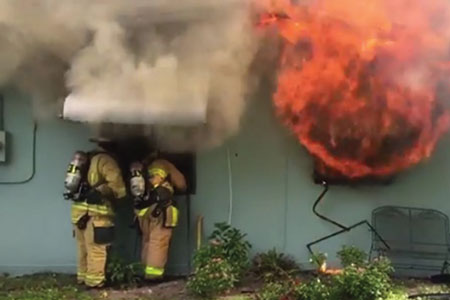 |
| (1) With reports of a woman and baby trapped inside this house, a crew prepares to make entry through a bedroom window and search the only survivable room in the structure. Are you and your personnel equipped, trained, and willing to make this search? It is worth the risk. (Photo 1 by Ken Rudominer; all others by author.) |
You take command as the first officer on scene and report a working fire in a one-story single dwelling, heavy fire showing in the rear and from windows on the Bravo and Delta sides. You advise that you are stretching a line. Several frantic citizens are outside. One is screaming that her mother is trapped in her bedroom, saying she tried to get her out but was overwhelmed with smoke and exited the residence with her children.
You look around the scene and see the initial hoseline stretched and charged at the opened front door with heavy smoke pushing out through the upper part of the doorway. A rescue company has arrived; personnel are in full gear and approaching you and the frantic daughter. You hand the thermal imaging camera (TIC) to a rescue firefighter and direct him, “Go with her and VEIS [vent-enter-isolate-search] the window she shows you; we’ve got an elderly female trapped.”
 |
| (2) The search position firefighter (FF) climbs the ladder as the window position FF dons face piece and gloves. Note the search position FF is on air and is carrying the halligan up to use during his search. Prior to climbing the ladder, the search position FF had hung the six-foot roof hook on an upper rung so he can use it to vent the window. |
You make your way to the front door, where a firefighter has just bled the line; you plug in your regulator; and, as you’re about to make entry, the overhead at the front door lights up. You advise incoming units that an offensive fire attack and coordinated VEIS are underway. You and the firefighter make entry, knocking down fire from the front door, and advance into the living space and the kitchen where the solid firefight ensues. With a keen ear to the radio, you hear multiple units arriving on scene. The arriving battalion chief takes command, and you hear the transmission you were waiting to hear: “Rescue 46 to Command, we are removing a victim from the window, Delta side; we need personnel and the stretcher ASAP!”
You and your crew succeeded in simultaneously suppressing the fire and making a rescue. It may be the only time in your career that you will be first due at a fire like this, and all on scene did their jobs just as they were trained to do.
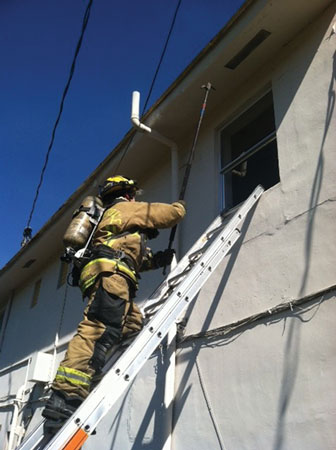 |
| (3) The search position FF ventilates the window from a ground ladder. Note the modified leg lock using a simple knee press to a higher rung. This member must be on air and ready to make immediate entry. The member is positioned under the windowsill for safety should the fire react violently on ventilation. The tips are positioned at the sill, and the ladder is at an exaggerated climbing angle. |
Unfortunately, sometimes things just don’t work out as well. If this scenario’s outcome were less favorable for the firefighters or the citizen in need of rescue, inadequate training is not the reason. Sometimes the fate of those requiring our rescue aid is sealed before we arrive; we have to accept that. Sometimes our actions dictate the fate of that person. This is what we sign up for when we raise a hand and swear to protect our citizens. We will engage in interior firefights to protect life and property. In the heat of the moment, we will always revert to our training.
The Fort Lauderdale (FL) Fire Department’s engine and ladder companies are staffed with three personnel: a captain, a driver/engineer, and a firefighter. Our rescue companies are patient transport units (called ambulances in other places) that are staffed with two firefighter/paramedics. “Firefighter” is first because we are a traditional fire department that happens to transport a lot of patients to the hospital. Like most urban area departments around the country, emergency medical services (EMS) and transport units were introduced into operations within the past 15 to 20 years.
 |
| (4) The search position FF vents the window while the window position FF has donned SCBA and gloves and is ready to climb. |
Most structure fires in our city are residential and mostly occur in one- and two-story dwellings. Any well-trained firefighter can get very good at stretching and advancing hose in these buildings and will also be very good at searching for occupants after making entry from the front door. In my department, most of our searches for trapped occupants at these residential fires turn out to be negative. In most of these fires, the search begins at the front door or whatever entryway is used for the initial attack line.
But what happens at a fire that is not the “most of the time” fire, where there is a report of someone trapped and the normal entry is untenable for a search team to enter quickly? This transforms a bread-and-butter fire into a high-risk/low-frequency event. Does your department have fireground procedures in place for this type of incident? Do you train on what you need to do at this type of incident? If not, how will your actions play out like second nature? Most importantly, are you ready to uphold your oath to put the life of a citizen before your own?
 |
| (5) The search position FF has vented the window, cleared the frame/sash, and is about to make entry. The window position FF begins to ascend the ladder, ideally with a TIC so that the member can monitor conditions and search progress. |
The best way to succeed here, as with most incidents, is to maintain strict discipline on the basics and to always fall back on your training. In the past, VEIS was VES and did not emphasize the importance of “isolate” by closing the bedroom door. As research continues and incidents occur, “isolate” must be reinforced. We’ve all heard that today’s fires are burning hotter and faster than in the past. Hence, firefighters who are venting a window intending to search that room must be aware that time is of the essence and their time to search that room depends on their ability to quickly locate and close the bedroom door. “Isolate” was added to VES to emphasize that firefighters must remember to close the door. This is not a new tactic; it only emphasizes the importance of isolation in the procedure.
Ventilation, entry, and search are performed separately on each fireground; however, combining them into one single operation is an entirely different procedure. When we ventilate a structure, we do it for fire or for life. In my department, all ventilation must be coordinated with fire attack. Venting for fire is our most frequent ventilation task. Venting for life and then entering and searching for life are not commonly performed. For this reason, we must closely examine and practice the procedure of VEIS to ensure a successful rescue described in the above scenario.
VEIS Defined
VEIS can be defined as the creation of openings or the breaking of windows to gain access from an exterior position to carry out a primary interior search in a high-risk area of a structure. VEIS is performed without the protection of a hoseline and so is a very hazardous operation. Strict discipline in training is vital to its success on the fireground. Although it puts firefighters in great danger, VEIS has proven to enable civilian rescues at structure fires. It places firefighters in high-target locations where potential victims may be found.
In VEIS, the key is to locate and rescue trapped occupants as quickly as possible in conjunction with other fireground activities. The tactic builds on the fire service principle of “risk a lot to save a lot.”
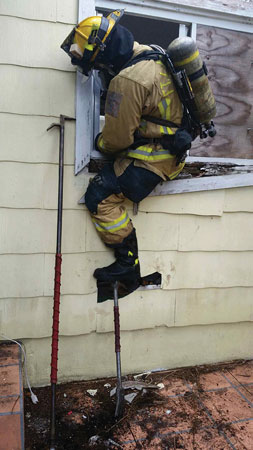 |
| (6) The search position FF is making entry at this first-floor window. For training purposes, only half of the window was used to prevent further damage to this structure. Note that the roof hook is placed near the window to be used as a reference point from the windowsill and the halligan bar is used as a step to assist in making the entry. |
Although it should not be implemented at every structure fire, VEIS has saved the lives of potential fire casualties. A great picture in my fire department’s Fire Museum shows members making such a rescue at a two-story residential dwelling in 1993. Unfortunately, the two sisters rescued from their second-story bedroom window succumbed to the products of combustion to which they had been exposed. But the aggressive search and rescue of these two young lives gave them a fighting chance.
Although I focus on an aggressive search and rescue procedure, I must emphasize that you should never delay suppression activities to conduct a search. It is highly important to understand that locating, confining, and extinguishing the fire is our first priority. Once water is being applied to the fire, generally everything begins to improve.
Second, ideally, there will be enough personnel on scene to allow conducting a conventional interior search in conjunction with the targeted VEIS operation. You can conduct a search from the interior more quickly than a VEIS, which limits crews to searching one room at a time from the exterior.
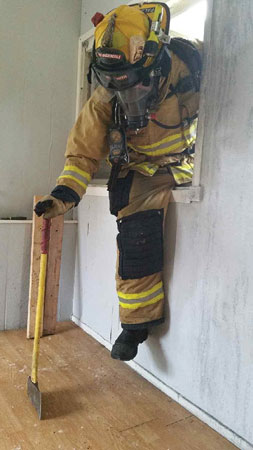 |
| (7) After sweeping the floor with a boot to check for any victims at the windowsill, the search position FF sounds the floor for integrity prior to entering. He uses a flathead ax here to sound the floor, since the halligan was used as a step to enter the room. |
Again, VEIS is not appropriate for every fireground. Implement it at fire scenes where there is a high life hazard probability. It is also typically practiced on, but not limited to, residential firegrounds.
Another situation in which VEIS is appropriate is when a truck or rescue company arrives on scene before an engine company. With trapped occupants reported and no engine on scene to facilitate fire control, personnel arriving in these units may be unable to conduct a conventional interior search from a doorway and may use VEIS tactics.
Underwriters Laboratories (UL) studies have confirmed that past practices regarding ventilating windows had created a dangerous flow path for firefighters and potentially could make interior conditions nonsurvivable for any trapped occupants. Remember that as soon as you ventilate a window or open a door, you create a flow path in which the products of combustion – heat, smoke, and fire gases – will travel. UL’s research has emphasized the importance of the “isolate” task in VEIS. Do not delay in getting to the bedroom door and isolating the room from fire. The past practice of using an extension ladder’s tips to ventilate an upper-floor bedroom window should not be advocated or practiced. Although we will operate more efficiently, effectively, and safely today because of this research, the fire service must never forget its primary mission – extinguishing fires and saving lives. Civilians’ lives come first – we are here for them. When you arrive at a house fire, they just want you to get them out.
VEIS: When, Where, How, Why
When
Trapped Occupants. On arrival, the first-due company will either have a known life hazard (confirmed trapped occupants), a suspected life hazard (possible/unknown presence of occupants), or a report that all occupants are accounted for. With a report of confirmed trapped occupants, the aggressive search tactic of VEIS is a high priority. Also important is finding out the victim’s location in the structure, based on information from family members or witnesses from the outside directing fire crews. There are documented VEIS rescues from around the country in which a person met the arriving responders and pointed to a window stating, “I saw her right there calling for help, and then she collapsed.” If this is not the situation – i.e., a late-night residential fire with no one able to direct crews to the victim’s location – the officer in charge must decide if, when, and where to employ VEIS. This will be based on the presence of cars in the driveway, the location of the bedrooms, and the common entry/exit pathways.
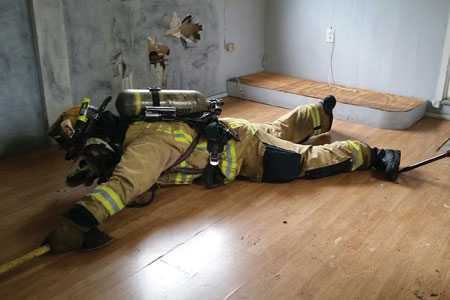 |
| (8) The search position FF then lies flat on the floor under the smoke to get a layout of the room and to locate the bedroom door. The roof hook to the right of the firefighter’s foot provides a reference point toward the window’s location. |
Fire Conditions. Once a report of trapped occupants is confirmed, implementing VEIS should be based on fire conditions. You must use a risk vs. benefit size-up: If there is potential for a savable life, use the VEIS tactic when applicable. If a room has already flashed over and is venting out the window of the location of a reported trapped occupant, this would be a “no-go” situation. In that room, no viable victim can be rescued. If fire is venting out of every window in the residence except one and there is a report of trapped occupants, then consider that one window for a VEIS operation, since it may be the only survivable area of the structure. What is the risk? What would you want the fire department to do for your family (photo 1)?
Where
Since VEIS is typically performed on residential structures, crews most likely will perform this aggressive tactic from bedroom windows. Statistics show the highest life hazard during a fire, regardless of the time of day, is in the bedroom. A typical VEIS maneuver would be performed from windows at a location where a victim is in the most danger. For single-story residential fires, the VEIS team should consider entry at a window adjacent to or near the fire area. For multistory residential fires, the VEIS team should consider entry either adjacent to or directly above the fire area. Remember, when there is someone outside who can direct crews toward the location of a trapped occupant, give this location the highest priority.
How
Caution! A two-person team performs VEIS. One member searches the room while the second team member remains at the window with a TIC (ideally) and a flashlight to monitor heat conditions; keep a watch on the member conducting the search; and direct the member to a victim, if found, using the TIC.
VEIS is a very dangerous task to perform on the fireground. Below are the generally accepted procedures to perform this operation. Since some may say this is an unsafe act (i.e., sending one person in to conduct a search, searching without a charged hoseline), we must realize that we are no longer in the fire academy. No state examiner is here criticizing your actions – only live citizens you must rescue.
The VEIS team will have at least two members equipped with a TIC, a flashlight for each member, a six-foot hook, a halligan tool, and a ladder (if the entry point is above the first floor – the ladder size depends on the location of the entry). Once you have confirmed the need for VEIS and chosen a location for entry, the following procedure is a generally accepted guideline for performing VEIS.
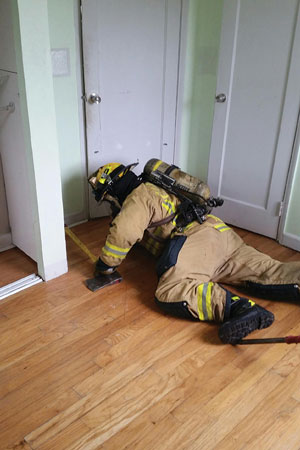 |
| (9) Although the bedroom door was already closed, the searcher briefly opens it to check for victims and assess fire conditions, then closes it. |
One team member (the search position firefighter) will vent the window, make entry, and search while the other team member (the window position firefighter) remains at the window. Remember to make the window into a door by removing the sash, the blinds, or any other obstacle that could hinder a rapid escape.
As the window is being vented, the window position member must be masked up and ready to operate. If venting the window from a ground ladder (photos 2-5), perform a fast, modified leg lock or knee press maneuver. Doing it the fire academy way takes too much time and effort. Remember that life is depending on you and time is running out.
The search firefighter remains low, straddling the windowsill, and feels for a floor/victims at the sill with one foot. Once a floor is felt and no victims have been found there, the search member sounds the floor with a halligan to confirm stability and make entry into the room (photos 6-7).
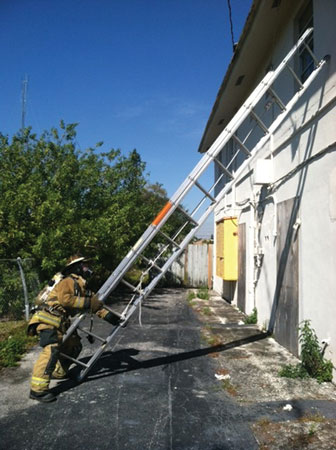 |
| (10) One member rolls the ladder from one window to the next to perform VEIS again at another location. |
Immediately after entry, the search firefighter gets below the smoke, lies on the floor, and visually searches the floor for any victims and locates the bedroom door (photo 8).
The window firefighter places the six-foot hook on the sill so that the handle is within the room. This gives the search position a physical reference point/lifeline toward the exit if conditions deteriorate rapidly and he must escape.
The search position firefighter must get to the bedroom door as quickly as possible. Remember, venting the window has created a flow path, and the time inside the room is very limited unless the door can be controlled. If the door is already closed, open it briefly to assess for fire conditions in the hallway and any victims just outside the bedroom door. Close the door. If the door is open, check outside the door briefly for fire conditions and victims, and then shut the door (photo 9).
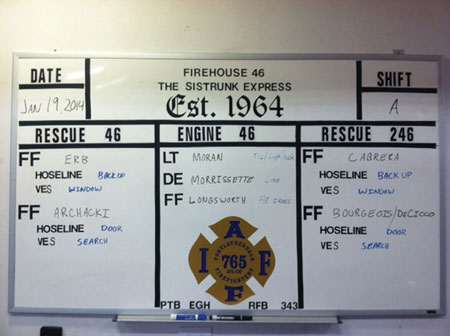 |
| (11) The morning lineup has personnel assignments for the hoseline and for a possible VEIS scenario. |
Assessing for fire conditions in the hallway or the area outside the bedroom will give the VEIS member an idea of how bad the conditions are inside the structure and how much time the member will have to search the room of entry.
Assessing for a victim just outside the bedroom door is necessary because during a fire, an occupant will attempt to flee the area using the normal entry/exit pathways and may have succumbed to products of combustion just outside of a room while attempting to escape.
While checking for fire conditions and for the presence of victims on the other side of the door, it is imperative to understand that the inside VEIS team member does not leave the room of entry by any other means except the window by which entry was made.
Once the door is closed, conduct a rapid search of the room. If you find victims, remove them through the bedroom window. If you don’t find victims, exit the room through the window and continue the search for trapped occupants at the next window if warranted, following this procedure. If you must move the ground ladder to another window to repeat the VEIS procedure, one member can quickly and safely get the ladder into position. Position yourself in an athletic stance, and roll the ladder along the building until in position at the next window (photo 10).
Why
Ventilation, entry, isolation, and search are four actions on every fireground. Generally, under normal fireground operations at a bread-and-butter fire, firefighters enter through the structure’s front door, ventilate to aid fire suppression, and conduct search while fire suppression is ongoing. When a known life hazard exists and fire conditions permit, firefighters can use a different approach (VEIS) and search above or ahead of the fire to locate and save lives.
Occupants of the fire structure become trapped when advancing fire cuts off their escape path. Often, they will flee to a room with a door – i.e., the bedroom or bathroom – to get away from the products of combustion. In these circumstances, firefighters must take great risks to reap the great rewards of saving a life. The VEIS tactic, when it can be performed, places firefighters in a high-life-hazard area of the structure to search for viable victims.
Like any fireground task, you must train on VEIS procedures and must have a game plan in place before an incident requiring it occurs. With a plan in place the first thing in the morning, you will avoid any confusion about the role of personnel on scene (photo 11). The officer also has an option to call an audible after arriving on scene and finding conditions that would warrant a different plan.
High-risk/low-frequency events like the scenario at the beginning of this article demand performance based on solid training fundamentals, such as a “suppression first” mindset. Getting caught up in all the medical calls can cloud our vision of our first duty as firefighters: suppression. Keeping this foremost in our thoughts and habits around the firehouse and in training, drilling, and practicing, it will become a natural, expected part of our day.
DANNY MORAN is a captain with the Fort Lauderdale (FL) Fire Department and is assigned to Engine 8. He is a fire service instructor III and live fire training instructor at Miami Dade College School of Fire Science. Moran is a coordinator and a HOT instructor for the Fort Lauderdale Fire Expo and an engine company operations instructor for the Orlando Fire Conference. He is the president of South Florida F.O.O.L.S. and has a bachelor’s degree in criminal justice from Florida International University.
VEIS: The Basic Fundamentals
VEIS: The Engine Company’s Perspective
VEIS, a Tactic for Today’s Fires
Fire Engineering Archives

